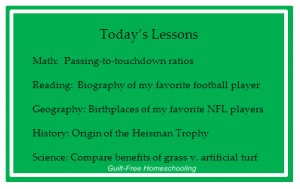A GFHS reader wrote to me, concerned about her student’s lack of interest in doing homeschool lessons, although he showed a wide capacity for learning and retaining facts about sports. The mom was frustrated as to how to get any actual lessons accomplished, since their days were an endless series of disagreements and strife. This is when out-of-the-box thinking can really pay off. Taking the lessons out of the box and away from the textbooks can make a huge difference and ignite the spark of learning in a “reluctant” learner such as this student. The examples given here will relate to football (this particular child’s passion), but you can easily adapt these ideas to wherever your students’ interests lie.
When a child is keenly interested in football or other sports, that can be used as an “in” for other subjects. For instance, put a map of the USA on a bulletin board and have him stick a pin in the approximate places where his favorite NFL players were born. Then have him place another pin in the city where each player went to college and connect the two pins for each player with a piece of yarn. Suddenly he’ll be up to his elbows in a fascinating research project and geography lesson that doesn’t feel like schoolwork to him at all!
Take this in a slightly different direction by challenging him to do some research on the NFL teams, making a chart showing when each team was founded, where it began, and if or where it has moved. Have some of the teams’ names or colors or mascots changed throughout the years? Now he’s found a history lesson that he can really enjoy! Give him more pins for the map (and a different color of yarn) to show the movements of the teams. A little more research can reveal what important world events coincided with significant team events or crucial games for more history, this time linking football to other events. Find inventions or products that were introduced during the years that match up to his favorite events regarding games, teams, or players, and that can bring in some science lessons. Look at how football uniforms, pads, helmets, and other equipment have changed over the years and why for some more science and history.
Challenge him to research the backgrounds of a few favorite players and write “color commentary” that could be used by a sportscaster, and you’ll have a writing assignment he’ll be eager to do! Challenge him to write his own sports “column” or read and critique the sports columns or blogs by professional sports writers, and he’ll have reading material, comprehension studies, and analytical writing assignments that hold his interest. To round out the language arts lessons, focus on his content first, then work on helping him correct spelling, punctuation, and grammar — always examining the rules for each change, not just criticizing his writing without reasons. He may even learn to spot spelling and grammar errors in the professionals’ columns for an important lesson in why accuracy matters!
Players’ statistics can be analyzed for some practical, real-life applications in math. Calculate the total yards of passing or rushing, the percentage of completed passes, or how a player’s averages have improved or declined over his career. Math practice is math practice, regardless of whether it uses random problems on a worksheet or real-life statistics. When the real-life applications mean something to the student, he will have motivation to complete the work. Learning one fact will spur curiosity to learn more facts, and before long, the student will be knee-deep in new information and hungry for more.
The homeschooling mom mentioned earlier took this advice and began adapting lessons to her son’s interest in football. When his curriculum focused on poetry, they searched the internet for poems about football—and were delighted with their results. One poem prompted a discussion, which led to further studies and more topics. This simple substitution transformed a struggle over a single, uninteresting lesson into a day filled with curiosity, researching, exploring, and learning.
Lessons that are based on real-life interests will combine several academic subjects all at once, rather than following the institutional school model of working on each individual subject for forty minutes before switching to the next unrelated subject for the next forty-minute period. Your student can research a given topic, study and analyze the reading material, pursue more research as to the geography, science, or history related to the topic, perform some math calculations to gain better understanding of the data, create a timeline of events, and express his conclusions and personal opinions in a variety of formats. The analysis of the information is conveyed, whether it takes on the form of a formal essay, a news story, editorial column, a poem, song, or rap, or even a personal journal entry. My own student who was reluctant to read assigned stories outside his field of interest became a voracious reader when the subject matter fed his curiosity. (How many adults would waste valuable time reading things in which they have no interest?) Adapting lessons to your students’ interests teaches those students how to learn from every facet of life and sets them firmly on the path to life-long learning.
See also:
The Value of Supplemental Activities
10 Ways to Improve a Lesson
How Can I Teach Out-of-the-Box Thinking?
Is Learning Limited to Books?
Every Day Is a Learning Day, and Life Is Our Classroom






 Guilt-Free Homeschooling is the creation of Carolyn Morrison and her daughter, Jennifer Leonhard. After serious disappointments with public school, Carolyn spent the next 11 years homeschooling her two children, from elementary to high school graduation and college admission. Refusing to force new homeschooling families to re-invent the wheel, Carolyn and Jennifer now share their encouragement, support, tips, and tricks, filling their blog with "all the answers we were looking for as a new-to-homeschooling family" and making this website a valuable resource for parents, not just a daily journal. Guilt-Free Homeschooling -- Equipping Parents for Homeschooling Success!
Guilt-Free Homeschooling is the creation of Carolyn Morrison and her daughter, Jennifer Leonhard. After serious disappointments with public school, Carolyn spent the next 11 years homeschooling her two children, from elementary to high school graduation and college admission. Refusing to force new homeschooling families to re-invent the wheel, Carolyn and Jennifer now share their encouragement, support, tips, and tricks, filling their blog with "all the answers we were looking for as a new-to-homeschooling family" and making this website a valuable resource for parents, not just a daily journal. Guilt-Free Homeschooling -- Equipping Parents for Homeschooling Success!

Recent Comments